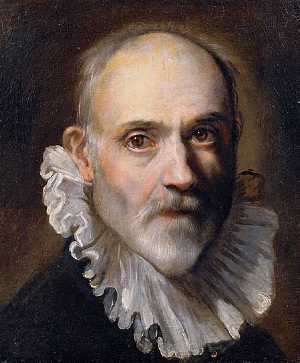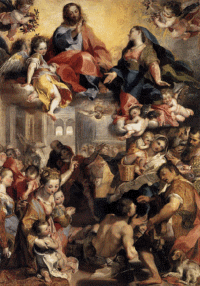 SKC Films Library SKC Films Library |
| SKC Films Library >> Fine Arts >> Painting >> Italy |
 Federico Barocci Federico Baroccipainter known as much for his sketches as his paintings Federico Barocci (aka Federico Fiori) was born in Urbino, Italy, in 1535. He received his earliest apprenticeship with his father, Ambrogio Barocci, a sculptor of some local eminence, and was then apprenticed with the painter Battista Franco in Urbino. In 1548 he went to Rome, where he worked in the studio of the Mannerist painters Taddep and Federico Zuccari. According to artist biographer Giovanni Bellori, Barocci met Michelangelo while After four years in Rome, he returned to his native city, where his first work was a St. Margaret executed for the Confraternity of the Holy Sacrament. He was subsequently invited back to Rome by Pope Pius IV to assist in the decoration of the Vatican Belvedere Palace, where he painted the Virgin Mary and infant, with several Saints and a ceiling in fresco, representing the Annunciation. During his latter period in Rome, Barocci fell ill with intestinal complaints. Barocci suspected he had been poisoned by rivals jealous of his talent and the encouragement he got from Michelangelo, and while such was true has never been determined he suffered from digestive distress for the rest of his life. Although he remained productive for another 47 years after the "poisoning," the discomfort he suffered was such that he vomited after every meal, slept fitfully and was plagued by nightmares, and could paint for only two hours a day. It also led to him returning to Urbino in 1563 for its pure air. Apart from brief trips to Perugia, Arezzo and Florence, Barocci remained in Urbino for the rest of his life, pleading ill-health to escape offers from both Philip II of Spain and the Holy Roman Emperor Rudolf II to join their respective courts. Although he continued to have major altarpiece commissions from afar, he was mainly patronized in his native city by Francesco Maria II della Rovere, Duke of Urbino. Barocci's chronic stomach complaint led him to develop
a highly unusual working practice. Painting three-metre
tall altarpieces was too physically demanding for a man
who was permanently nauseous, so Barocci minimised his
time in front of the canvas by meticulous
preparation. He did innumerable sketches: gestural,
compositional, figural studies (using models), lighting
studies (using clay models), perspective studies, color
studies, nature studies, etc. Today, over 2,000 drawings
by him are extant. Every detail of his subsequent
cartoons for canvases was worked out in this way. While his meticulous preparation practice was unique to his day, it was Barocci's use of color that most visually set him apart from his contemporaries. A lay member of the Capuchin mendicant preaching order, he believed that worshippers responded most deeply to color and sentiment. As a result, no figure in his paintings wears just one color, but always two or three to seduce the viewer into entering the scene. Barocci was also a good painter of babies, and also liked to include animals in his paintings. He died in Urbino in 1612. SOURCES |
| SKC Films Library >> Fine Arts >> Painting >> Italy This page was last updated on 05/20/2017. |
